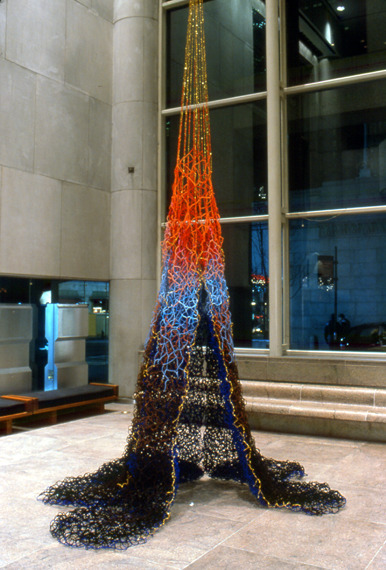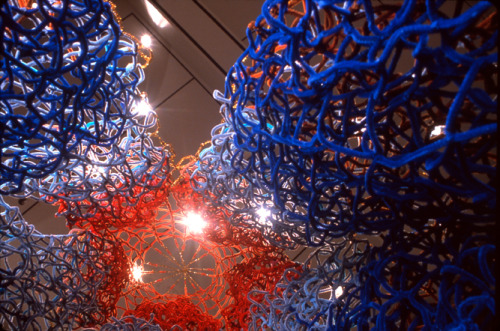Dikeou Superstars: Lucky Debellevue

2011 was a year of growth for The Dikeou Collection. The Dikeou Pop-Up Space opened in The Golden Triangle District with new painting and sculptural installations by Nils Folke Anderson, and new work by Devon Dikeou and Lucky DeBellevue were added into the fold at The Dikeou Collection. Although they differ both formally and conceptually, Anderson and DeBellevue’s work both fit perfectly within the theoretical framework of the collection. Like Agathe Snow’s “Sludgie the Whale” and Johannes Vanderbeek’s “Newspaper Ruined,” these acquisitions amplify and celebrate works made with humble materials that manifest in monumental scale. DeBellevue utilized hundreds of chenille stems (AKA pipe cleaners) to create his towering yet inviting “Otter,” which envelopes the viewer in its fuzzy and kaleidoscopic embrace.
[caption id="attachment_4929" align="alignnone" width="500"] DeBellevue, Lucky 2002
DeBellevue, Lucky 2002
Khlysty, the Owls, and the Others
LDBF0206
installation view Whitney Museum at Philip Morris
January 18 Ð April 5
Otter 2001
chenille stems
height variable x 115" diameter (detail)[/caption]
Suspended from the ceiling by glittering gold chenille stems and then gracefully spilling onto the floor in rich shades of red, blue, and black, the shape of “Otter” is reminiscent of a teepee with a triangular opening for people to enter. One’s experience of the work shifts from viewing the sublime to stepping inside a velveteen lattice cocoon. The title of the work is a nod to a slang term in the gay bear community, and “[uses] coded references that categorize interests within a particular community […] as objects kind of hiding in plain sight.” DeBellevue does not typically title his work, but in this case the title spurs delight in all, whether they know the true meaning or not.

DeBellevue’s use of chenille stems take on different forms and usages within the larger scope of his oeuvre. They figured prominently in his sculptures for about ten years from the early 90s to early 2000s (“Otter” was made in 2002) before implementing them as tools in his later 2-dimensional works. In his Untitled prints from 2011, DeBellevue used the chenille stems as stamps where he would bend them into different shapes, apply paint, and then press on to the paper. There are four of these 2-D works at The Dikeou Collection, and when placed within the same context as the sculpture new paradoxes arise. Is the sculpture a 3-dimensional drawing? The drawings are 2-dimensional sculptures? To the artist, it is a way to explore the various ways materials can be used. When the scope of DeBellevue’s work is looked at chronologically, one can see how the flecks from one series of work becomes more prominent in the next, like a continuous evolution of material development. Good art is a balance of change and consistency, and the focus on pattern, minimalism, and abstraction paired with a progressive approach to materiality makes DebBllevues creative world a magical and warming place to explore.
-Hayley Richardson
